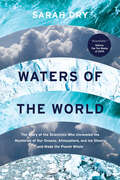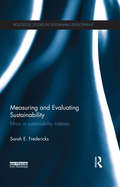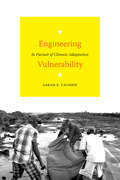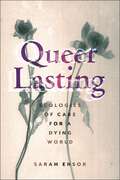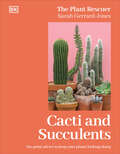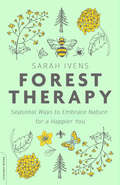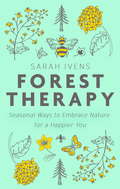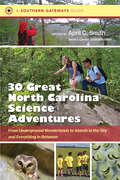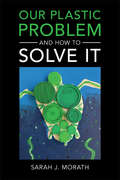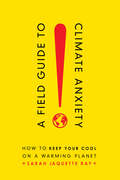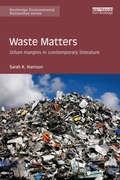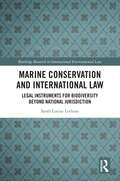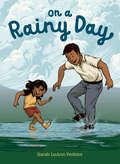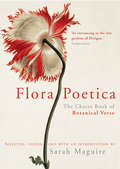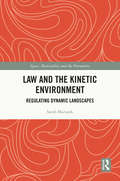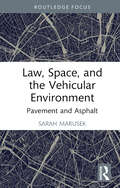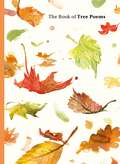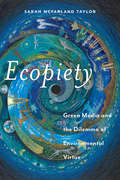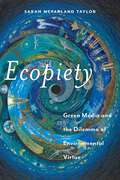- Table View
- List View
Waters of the World: The Story of the Scientists Who Unraveled the Mysteries of Our Oceans, Atmosphere, and Ice Sheets and Made the Planet Whole
by Sarah DryA Nature Top Ten Book of the Year: “Immensely readable” accounts of seven pioneers who were at the forefront of what we now call climate science (New York Review of Books).One of Booklist’s Top Ten Sci-Tech Books of the YearFrom the glaciers of the Alps to the towering cumulonimbus clouds of the Caribbean and the unexpectedly chaotic flows of the North Atlantic, Waters of the World is a tour through 150 years of the history of a significant but underappreciated idea: that the Earth has a global climate system made up of interconnected parts, constantly changing on all scales of both time and space. A prerequisite for the discovery of global warming and climate change, this idea was forged by scientists studying water in its myriad forms. This is their story.Linking the history of the planet with the lives of those who studied it, Sarah Dry follows the remarkable scientists who summited volcanic peaks to peer through an atmosphere’s worth of water vapor, cored mile-thick ice sheets to uncover the Earth’s ancient climate history, and flew inside storm clouds to understand how small changes in energy can produce both massive storms and the general circulation of the Earth’s atmosphere. Each toiled on his or her own corner of the planetary puzzle. Gradually, their cumulative discoveries coalesced into a unified working theory of our planet’s climate.We now call this field climate science, and in recent years it has provoked great passions, anxieties, and warnings. But no less than the object of its study, the science of water and climate is—and always has been—evolving. By revealing the complexity of this history, Waters of the World delivers a better understanding of our planet’s climate at a time when we need it the most.“One of the richest books I have ever read . . . a beautifully written, episodic, yet comprehensive, history of the diverse scientific underpinnings of climate science over the past two hundred years.” —Environmental History“Smart, compelling, and timely . . . By focusing on specific scientists, Dry gifts readers with entertaining portraits of some thoroughly interesting if largely unknown individuals.”—Booklist (starred review)
Measuring and Evaluating Sustainability: Ethics in Sustainability Indexes (Routledge Studies in Sustainable Development)
by Sarah E. FredericksThe indexes used by local, national, and international governments to monitor progress toward sustainability do not adequately align with their ethical priorities and have a limited ability to monitor and promote sustainability. This book gives a theoretical and practical demonstration of how ethics and technical considerations can aid the development of sustainability indexes to overcome this division in the literature and aid sustainability initiatives. Measuring and Evaluating Sustainability develops and illustrates methods of linking technical and normative concerns during the development of sustainability indexes. Specifically, guidelines for index development are combined with a pragmatic theory of ethics that enables ethical collaboration among people of diverse ethical systems. Using the resulting method of index development, the book takes a unique applied turn as it ethically evaluates multiple sustainability indexes developed and used by the European Commission, researchers, and local communities and suggests ways to improve the indexes. The book emphasizes justice as it is the most prevalent ethical principle in the sustainability literature and most neglected in index development. In addition to the ethical principles common to international sustainability initiatives, the book also employs a variety of religious and philosophical traditions to ensure that the ethical evaluations performed in the text align with the ideals of the communities using the indexes and foster cross-cultural ethical dialogue. This volume is an invaluable resource for students, researchers and professionals working on sustainability indicators and sustainability policy-making as well as interdisciplinary areas including environmental ethics; environmental philosophy; environmental or social justice; ecological economics; businesses sustainability programs; international development and environmental policy-making.
Engineering Vulnerability: In Pursuit of Climate Adaptation
by Sarah E. VaughnIn Engineering Vulnerability Sarah E. Vaughn examines climate adaptation against the backdrop of ongoing processes of settler colonialism and the global climate change initiatives that seek to intervene in the lives of the world’s most vulnerable. Her case study is Guyana in the aftermath of the 2005 catastrophic flooding that ravaged the country’s Atlantic coastal plain. The country’s ensuing engineering projects reveal the contingencies of climate adaptation and the capacity of flooding to shape Guyanese expectations about racial (in)equality. Analyzing the coproduction of race and vulnerability, Vaughn details why climate adaptation has implications for how we understand the past and the continued human settlement of a place. Such understandings become particularly apparent not only through experts’ and ordinary citizens’ disputes over resources but in their attention to the ethical practice of technoscience over time. Approaching climate adaptation this way, Vaughn exposes the generative openings as well as gaps in racial thinking for theorizing climate action, environmental justice, and, more broadly, future life on a warming planet.Duke University Press Scholars of Color First Book Award recipient
Queer Lasting: Ecologies of Care for a Dying World (Sexual Cultures)
by Sarah EnsorWhat queer modes of resilience and care can teach us about enduring environmental collapseWhat does it mean to live at the end of life, the end of a family line, the end of a species, or the end of the future itself? When faced with unfurling catastrophes, environmentalists often limit the conversation by focusing on the future. Activists work for the welfare of future generations, while scientists labor over projections of future outcomes. In Queer Lasting, Sarah Ensor asks what this emphasis on the future makes unthinkable. She looks to queer scenes of futurelessness to consider what ecocriticism can learn from queer theory, which imagines and inhabits the immanent ethical possibilities of a terminal present. While living “at the last” is often a terrifying prospect, queer culture reminds us that “to last” is itself also one way to go on. Defining queerness as a mode of collective life in which these paradigms of lasting—ending and persisting—are constitutively intertwined, Ensor turns to two periods of queer extinction for models of care, continuance, and collective action predicated on futurelessness: the 1890s, in which existing forms of erotic affiliation were extinguished through the binary of homo/heterosexuality, and the 1980s, in which the spread of the AIDS epidemic threatened the total loss of gay lives and of specific erotic ways of life. Through readings that trace unexpected formal resonances across the works of Sarah Orne Jewett, Willa Cather, Melvin Dixon, Essex Hemphill, Allen Barnett, and Samuel Delany, Queer Lasting maintains that queer writing, in its intimacy with death and loss, offers a rich archive for imagining new ways of thinking through environmental collapse. Whether confronting the epidemic contours of the AIDS crisis, theorizing the temporary encounters of cruising, or reckoning with the lives of non-reproductive subjects, this book about futurelessness is also a book about persistence. It demonstrates how, far from giving up in the face of the terminal paradigms that environmentalism fears, queer culture has instead predicated its living—and its lasting—upon them.
Cacti and Succulents: On-point Advice to Keep Your Plants Looking Sharp
by Sarah Gerrard-JonesStep into the fascinating world of succulents and cacti.Sarah Gerrard-Jones (@theplantrescuer) makes understanding, growing, and enjoying cacti and succulents simple. From learning about mature plants in their native habitats to showing you how to revive flagging cacti or propagating plants on your windowsill, this beautifully photographed guide has something to share with beginners and experienced enthusiasts alike.Learn how to create the best conditions for your plants to thrive indoors or out, discover new varieties to grow, and try planting projects to take your collection to the next level. Sarah’s engaging and passionate writing shares all her personal experience to ensure anyone can love looking after their cacti and succulents.
Nowhere Better Than Here
by Sarah GuilloryIn a town slowly being destroyed by rising tides, one girl must fight to find a way to keep her community’s spirit from drowning.For thirteen-year-old Jillian Robichaux, three things are sacred: bayou sunsets, her grandmother Nonnie’s stories, and the coastal Louisiana town of Boutin that she calls home.When the worst flood in a century hits, Jillian and the rest of her community band together as they always do—but this time the damage may simply be too great. After the local school is padlocked and the bridges into town condemned, Jillian has no choice but to face the reality that she may be losing the only home she’s ever had.But even when all hope seems lost, Jillian is determined to find a way to keep Boutin and its indomitable spirit alive. With the help of friends new and old, a loveable golden retriever, and Nonnie’s storytelling wisdom, Jillian does just that in this timely and heartfelt story of family, survival, and hope.In her stunning debut middle grade novel, Sarah Guillory has written a lush story about an indomitable girl fighting against the effects of climate change.
Frameworks for Water Law Reform
by Sarah HendryThe world is currently experiencing unprecedented global change, with population increase, urbanisation, climate change and environmental degradation combining to make management of freshwater resources a critical policy focus of the twenty-first century. This timely book designs and develops an original, analytical framework for water law reform processes, using case studies across four jurisdictions. Addressing the four principal areas of water law - integrated water resource management (IWRM) and river basin planning, water rights and allocation, water pollution and quality, and water services - this book provides a comprehensive study of water law, within the context of global and regional policy agendas. Case studies from England, Scotland, South Africa and Queensland, Australia, are presented, providing comparators from both common law and mixed jurisdictions, from the northern and southern hemispheres, and from developed and developing countries. A legislative framework is proposed for water law reform processes, and the consequences of different reform options are considered and investigated. A valuable resource for academics and graduate students in environmental law, resource management, hydrology and social science, this book is also highly relevant to policymakers, NGOs and legal practitioners.
Forest Therapy: Seasonal Ways to Embrace Nature for a Happier You
by Sarah IvensYour practical guide to better health, stronger relationships, and a happier life--by reconnecting with nature There is something simply soul-soothing about being in nature. In fact, research shows that spending time outside can improve the immune system, combat stress hormones, lower blood pressure, and boost self-esteem. Around the globe, rising movements are driving us to reconnect with Mother Nature--from shinrin-yoku ("forest bathing") in Japan to friluftsliv ("open-air life") in Scandinavia--yet our everyday lifestyles have distanced us from the great outdoors. For stressed-out professionals, reclusive bookworms, worn-out parents, and their cooped-up kids, Forest Therapy shares why getting back to nature is critically important for our well-being, and offers fun, easy practices to break out of hibernation.Forest bathing is a rising trend, but what to do if you're not near the woods or if the weather is dreary? Forest Therapy offers practical steps and inspiration to tap into nature's restorative power, no matter the season or the weather. Chapters address ideas for all four seasons, as well as ways to use experiences in nature as ways to deepen your relationships with your children, partner, and friends. Ivens's creative ideas and strategies range from a simple walk in the woods and countryside couples' therapy to DIY natural beauty products and simple ways to bring the great outdoors into your home. Illustrated with charming black-and-white line art, Forest Therapy is a warm, witty, and personal guide to improving your health, finding happiness, and living a fabulous al fresco life.
Forest Therapy: Seasonal Ways to Embrace Nature for a Happier You
by Sarah IvensWho hasn't felt better after a walk in the woods, a picnic alfresco or a swim in the sea? There is something soul-soothingly simple and refreshing about getting back to nature, about making the most of the great outdoors, being mindful of Mother Nature's gifts and grabbing spring and summer - and those blue sky, brisk days of autumn and winter - with both hands. But sadly it is a skill we are losing. We are becoming creatures wrapped in walls and trapped by to-do lists, hibernating while the world sprouts, grows and changes.From a simple walk in the woods and countryside couples therapy to DIY natural beauty products and how to bring the outdoors to your home, Forest Therapy will provide seasonal tips to help you reconnect with nature. This book is not just for mountain climbers or white water rafters - it is for uninspired fathers wanting to reconnect their families, bookworms looking to shake off their cobwebs, cooped-up kids needing to let off steam, stressed-out professionals wanting to stop and smell the flowers and worn-down mums needing a rejuvenating boost. We all know getting outside is good for us. Our ancestors did it. We should too. This book will help you live your most unforgettable, fabulous alfresco life.
Forest Therapy: Seasonal Ways to Embrace Nature for a Happier You
by Sarah IvensWho hasn't felt better after a walk in the woods, a picnic alfresco or a swim in the sea? There is something soul-soothingly simple and refreshing about getting back to nature, about making the most of the great outdoors, being mindful of Mother Nature's gifts and grabbing spring and summer - and those blue sky, brisk days of autumn and winter - with both hands. But sadly it is a skill we are losing. We are becoming creatures wrapped in walls and trapped by to-do lists, hibernating while the world sprouts, grows and changes.From a simple walk in the woods and countryside couples therapy to DIY natural beauty products and how to bring the outdoors to your home, Forest Therapy will provide seasonal tips to help you reconnect with nature. This book is not just for mountain climbers or white water rafters - it is for uninspired fathers wanting to reconnect their families, bookworms looking to shake off their cobwebs, cooped-up kids needing to let off steam, stressed-out professionals wanting to stop and smell the flowers and worn-down mums needing a rejuvenating boost. We all know getting outside is good for us. Our ancestors did it. We should too. This book will help you live your most unforgettable, fabulous alfresco life.
Thirty Great North Carolina Science Adventures: From Underground Wonderlands to Islands in the Sky and Everything in Between (Southern Gateways Guides)
by Sarah J. CarrierNorth Carolina possesses an astonishingly rich array of natural wonders. Building on this abundance, April C. Smith passionately seeks to open the world of nature to everyone. Her popular science guidebook features thirty sites across North Carolina that are perfect for exploration and hands-on learning about the Earth and the environment. A stellar group of naturalists and educators narrate each adventure, explaining key scientific concepts by showing you exactly where and how to look. This guidebook is for anyone—teens, kids, families, hikers, teachers, students, and tourists alike—who loves to be outside while learning.* All you need to plan trips and discover new attractions* Organized by the state's Mountain, Piedmont, and Coastal Plain regions* The 30 adventures spotlight wonderful places to hike, fascinating geological formations to find, animals and plants to observe, and hands-on learning activities* Explains clearly the scientific processes that made North Carolina the state it is today* Richly illustrated with photographs, diagrams, and maps; includes an indispensable science glossary
Our Plastic Problem and How to Solve It
by Sarah J. MorathPlastic pollution is a global problem that defies a singular solution. Our Plastic Problem and How to Solve It considers plastic's harm to the environment, from its production to its disposal, and offers a spectrum of solutions that require action by local and federal governments, businesses and non-profits, and individuals. Using specific examples and case studies, the book describes the history and chemistry of plastic, illustrates its harms, and points toward specific legislation and policies to offer concrete solutions. Plastic pollution is ubiquitous and has impacts on soil, food, air, and water. To solve our plastic problem, collaboration across disciplines will be critical; innovations in science, law, and design will be essential. The book demonstrates the need to approach environmental problems from an interdisciplinary lens, and will benefit anyone interested in learning more about the harms and solutions associated with plastic pollution.
A Field Guide to Climate Anxiety: How to Keep Your Cool on a Warming Planet
by Sarah Jaquette RayA youth movement is reenergizing global environmental activism. The "climate generation"—late millennials and iGen, or Generation Z—is demanding that policy makers and government leaders take immediate action to address the dire outcomes predicted by climate science. Those inheriting our planet’s environmental problems expect to encounter challenges, but they may not have the skills to grapple with the feelings of powerlessness and despair that may arise when they confront this seemingly intractable situation. Drawing on a decade of experience leading and teaching in college environmental studies programs, Sarah Jaquette Ray has created an "existential tool kit" for the climate generation. Combining insights from psychology, sociology, social movements, mindfulness, and the environmental humanities, Ray explains why and how we need to let go of eco-guilt, resist burnout, and cultivate resilience while advocating for climate justice. A Field Guide to Climate Anxiety is the essential guidebook for the climate generation—and perhaps the rest of us—as we confront the greatest environmental threat of our time.
Waste Matters: Urban margins in contemporary literature (Routledge Environmental Humanities)
by Sarah K. HarrisonHow do those pushed to the margins survive in contemporary cities? What role do they play in today’s increasingly complex urban ecosystems? Faced with stark disparities in human and environmental wellbeing, what form might more equitable cities take? Waste Matters argues that contemporary literature and film offer an insightful and timely response to these questions through their formal and thematic revaluation of urban waste. In their creation of a new urban imaginary which centres on discarded things, degraded places and devalued people, authors and artists such as Patrick Chamoiseau, Chris Abani, Dinaw Mengestu, Suketu Mehta and Vik Muniz suggest opportunities for an inclusive urban politics that demands systematic analysis. Waste Matters assesses the utopian promise and pragmatic limitations of their as yet under-examined work in light of today’s pressing urban challenges. This book will be of great interest to scholars and students of English Literature, Postcolonial Studies, Urban Studies, Environmental Humanities and Film Studies.
Fishing in Contested Waters
by Sarah KingAfter the Supreme Court of Canada's 1999 Marshall decision recognized Mi'kmaw fishers' treaty right to fish, the fishers entered the inshore lobster fishery across Atlantic Canada. At Burnt Church/Esgenoôpetitj, New Brunswick, the Mi'kmaw fishery provoked violent confrontations with neighbours and the Canadian government. Over the next two years, boats, cottages, and a sacred grove were burned, people were shot at and beaten, boats rammed and sunk, roads barricaded, and the local wharf occupied.Based on 12 months of ethnographic field work in Burnt Church/Esgenoôpetitj, Fishing in Contested Waters explores the origins of this dispute and the beliefs and experiences that motivated the locals involved in it. Weaving the perspectives of Native and non-Native people together, Sarah J. King examines the community as a contested place, simultaneously Mi'kmaw and Canadian. Drawing on philosophy and indigenous, environmental, and religious studies, Fishing in Contested Waters demonstrates the deep roots of contemporary conflicts over rights, sovereignty, conservation, and identity.
Dream. Unidos por el destino
by Sarah LarkDream. Unidos por el destino, es la segunda novela juvenil de la autora best seller Sarah Lark. Magníficamente escrita, invita al lector a disfrutar de una mágica historia el amor y la libertad. Sarah se muda con sus padres a Nueva Zelanda. A pesar de los paisajes de ensueño, Sarah no puede evitar echar de menos su antiguo hogar en Alemania, las cuadras y, sobre todo, al caballo del que se ocupaba allí. Empieza a interesarse por su nuevo hogar cuando, junto al atractivo y misterioso Lucas, descubre los caballos salvajes del monte Kaimanawa. Sarah se prenda de un semental plateado al que bautiza en secreto como Dream. Cuando Sarah se entera de que los caballos van a ser apresados y domados para hacer sitio al ejército, que necesita construir un campo de maniobras, Sarah está en shock. Para colmo, Dream acaba en manos de un brutal tratante de caballos y Sarah no puede evitar obsesionarse con una idea: ¿Cómo puede devolverle la libertad a Dream?
Marine Conservation and International Law: Legal Instruments for Biodiversity Beyond National Jurisdiction (Routledge Research in International Environmental Law)
by Sarah Louise LothianThis book provides a blueprint for an International Legally Binding Instrument (ILBI) for the conservation and sustainable use of marine biodiversity beyond national jurisdiction (BBNJ). The development of an ILBI could signify a pivotal turning point in the law of the sea by addressing regulatory, governance and institutional gaps and deficiencies in the existing international law framework for BBNJ. This book analyses the essential components an ILBI will require to effectively conserve and sustainably use BBNJ, focusing on marine genetic resources, areabased management tools, environmental impact assessments, capacity-building and marine technology transfer. It investigates potential areas of compromise, as the success of an ILBI will rely upon the support of a powerful bloc of maritime States, principally the United States, the United Kingdom, Russia, the Netherlands, France and Japan. The participation of major maritime powers will be critical as it is their nationals, corporations and flag vessels that have the financial and technical wherewithal to undertake activities beyond national jurisdiction. This bloc of States has historically been the strongest proponent of the Grotian doctrine of ‘freedom of the seas’ as it aligns with their predominant interest to preserve navigational freedom for their merchant and military fleets. Accordingly, this book assesses the extent to which the Grotian doctrine continues to exert influence on the development of the law of the sea and the development of an ILBI. Providing a comprehensive overview of this important development in international law, this book will be of interest to students, lecturers and academics of law of the sea, international environmental law and biodiversity law.
On a Rainy Day
by Sarah LuAnn PerkinsA sweet story of a father and daughter's cozy day together as they wait for a storm to pass When rain interrupts their outdoor play, a girl and her father retreat indoors to wait out the storm. As lightning cracks and thunder booms, they each have their own ideas of things they can do together on a rainy day.Told through spare text and bold sound effects, Sarah LuAnn Perkins' unique linocut-like textured illustrations create a fun read-aloud experience for both reader and listener.
Flora Poetica: The Chatto Book of Botanical Verse
by Sarah MaguireThis beautiful anthology brings together over 250 poems about flowers, plants and trees from eight centuries of writing in English, creating a rich bouquet of intriguing juxtapositions. Fourteenth-century lyrics sit next to poems of the twenty-first century; celebrations of plants native to the English soil share the volume with more exotic plant poetry. There are thirty poems about roses, by poets as diverse as Shakespeare, Dorothy Parker and the South African, Seitlhamo Motsapi; but there are also sections devoted to more unusual plants such as the mandrake, the starapple and the tamarind. An ex-gardener, the celebrated poet Sarah Maguire brings her extensive horticultural knowledge to bear on all the poems, arranging them into botanical families, identifying the plants being written about and writing a fascinating introduction. Whether you are a poetry lover, a gardener, a botanist, or simply the purchaser of the occasional bunch of flowers, this unique anthology allows you to luxuriate amidst the world's flora.
Law and the Kinetic Environment: Regulating Dynamic Landscapes (Space, Materiality And The Normative Ser.)
by Sarah MarusekThis book addresses the legal-geographical implications of the fact that landscapes are not static, but dynamic. Within the field of legal geography, the spatial relationship of law to landscape is usually considered to be static. Environments are often considered fixed, and consequently inert, as places that literally don’t go anywhere. Typically, then, it is what happens in these places, rather than the place itself, that commands academic attention. In contrast to this static viewpoint, Law and the Kinetic Environment considers how many landscapes are in flux and, as a result, may be seen as dynamic. Natural phenomena, such as oozing lava, moving glaciers, or bubbling geothermal pools, challenge and test the normative conceptualizations of stability of place, property ownership, and legal regulation. Consequently, such dynamic landscapes enliven and transform law, offering new jurisprudential insights into what law is and how it operates in response to the kineticism that, this book argues is, to some degree, inherent in all landscapes. This original engagement with legal geography will appeal to those with general interests in this area, as well as specific concerns with questions of law and place, property and the environment.
Law, Space, and the Vehicular Environment: Pavement and Asphalt
by Sarah MarusekThis book examines the paved road as a liminal space and legal frontier for enlivened, everyday struggles over property, power, and place/definition. Through pavement itself and the pavement-based practices of pavementalities and pavementeering, the road is legally framed as a place for movement. Paved terrain is a site of dynamism between law and place that engenders the road as legal metaphor by calling forth the kinetic notion of jurisprudence in which law can be understood through the fluidity of everyday life. In Western (and particularly American) society, roads are a material locus of governance, in which rights of way are determined, communicated, and enforced. However, roads also constitute a site of resistance or disruption, beyond regulation. Addressing phenomena such as travel, political protest, public memory, and community governance, this book explores the paved medium of asphalt as a complex surface for legality that constitutively frames order against disorder involving jurisdiction tensions, property ownership, and cultural identities in vehicular environments. The target audience of this book are those students and scholars who consider how law works in society, whether through frameworks of (auto) mobility and legal geography or through the interdisciplinary approaches of legal semiotics, legal culture, and/or new materialism.
The Book of Tree Poems
by Sarah MaycockCould there be a more pleasant way to spend a warm afternoon than lazing under a tree reading poetry inspired by these shade-giving wonders of the world? Trees have sparked some of the biggest literary imaginations over the ages and - as the climate emergency escalates - it has never been more important to appreciate our vital connection to them. This beautifully illustrated anthology of sixty tree poems is a celebration of our love of trees. With poems by some of the world's best-loved poets including Philip Larkin, Ted Hughes, Carol Ann Duffy, Thomas Hardy and Elizabeth Barrett Browning, The Book of Tree Poems will help you see trees as you've never seen them before.
The Book of Tree Poems
by Sarah MaycockCould there be a more pleasant way to spend a warm afternoon than lazing under a tree reading poetry inspired by these shade-giving wonders of the world? Trees have sparked some of the biggest literary imaginations over the ages and - as the climate emergency escalates - it has never been more important to appreciate our vital connection to them. This beautifully illustrated anthology of sixty tree poems is a celebration of our love of trees. With poems by some of the world's best-loved poets including Philip Larkin, Ted Hughes, Carol Ann Duffy, Thomas Hardy and Elizabeth Barrett Browning, The Book of Tree Poems will help you see trees as you've never seen them before.
Ecopiety: Green Media and the Dilemma of Environmental Virtue (Religion and Social Transformation #1)
by Sarah McFarland TaylorTackles a human problem we all share―the fate of the earth and our role in its future Confident that your personal good deeds of environmental virtue will save the earth? The stories we encounter about the environment in popular culture too often promote an imagined moral economy, assuring us that tiny acts of voluntary personal piety, such as recycling a coffee cup, or purchasing green consumer items, can offset our destructive habits. No need to make any fundamental structural changes. The trick is simply for the consumer to buy the right things and shop our way to a greener future.It’s time for a reality check. Ecopiety offers an absorbing examination of the intersections of environmental sensibilities, contemporary expressions of piety and devotion, and American popular culture. Ranging from portrayals of environmental sin and virtue such as the eco-pious depiction of Christian Grey in Fifty Shades of Grey, to the green capitalism found in the world of mobile-device “carbon sin-tracking” software applications, to the socially conscious vegetarian vampires in True Blood, the volume illuminates the work pop culture performs as both a mirror and an engine for the greening of American spiritual and ethical commitments. Taylor makes the case that it is not through a framework of grim duty or obligation, but through one of play and delight, that we may move environmental ideals into substantive action.
Ecopiety: Green Media and the Dilemma of Environmental Virtue (Religion and Social Transformation #1)
by Sarah McFarland TaylorTackles a human problem we all share―the fate of the earth and our role in its future Confident that your personal good deeds of environmental virtue will save the earth? The stories we encounter about the environment in popular culture too often promote an imagined moral economy, assuring us that tiny acts of voluntary personal piety, such as recycling a coffee cup, or purchasing green consumer items, can offset our destructive habits. No need to make any fundamental structural changes. The trick is simply for the consumer to buy the right things and shop our way to a greener future.It’s time for a reality check. Ecopiety offers an absorbing examination of the intersections of environmental sensibilities, contemporary expressions of piety and devotion, and American popular culture. Ranging from portrayals of environmental sin and virtue such as the eco-pious depiction of Christian Grey in Fifty Shades of Grey, to the green capitalism found in the world of mobile-device “carbon sin-tracking” software applications, to the socially conscious vegetarian vampires in True Blood, the volume illuminates the work pop culture performs as both a mirror and an engine for the greening of American spiritual and ethical commitments. Taylor makes the case that it is not through a framework of grim duty or obligation, but through one of play and delight, that we may move environmental ideals into substantive action.
